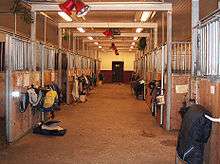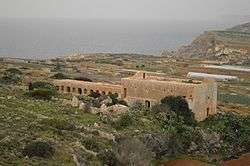Stable
| Look up stable in Wiktionary, the free dictionary. |



A stable is a building in which livestock, especially horses, are kept. It most commonly means a building that is divided into separate stalls for individual animals. There are many different types of stables in use today; the American-style barn, for instance, is a large barn with a door at each end and individual stalls inside or free-standing stables with top and bottom-opening doors. The term "stable" is also used to describe a group of animals kept by one owner, regardless of housing or location.
The exterior design of a stable can vary widely, based on climate, building materials, historical period and cultural styles of architecture. A wide range of building materials can be used, including masonry (bricks or stone), wood and steel. Stables can range widely in size, from a small building housing one or two animals to facilities at agricultural shows or race tracks that can house hundreds of animals.
History

The stable is typically historically the second-oldest building type on the farm. The world’s oldest horse stables were discovered in the ancient city of Pi-Ramesses in Qantir, in Ancient Egypt, and were established by Ramesses II (c.1304-1237 BC). These stables covered approximately 182,986 square feet, had floors sloped for drainage, and could contain about 480 horses.[1] Free-standing stables began to be built from the 16th century. They were well built and placed near the house due to the value that the horses had as draught animals. High-status examples could have plastered ceilings to prevent dust falling through into the horses’ eyes. Relatively few examples survive of complete interiors (i.e. with stalls, mangers and feed racks) from the mid-19th century or earlier.[2][3]
Traditionally, stables in Great Britain had a hayloft on their first (i.e. upper) floor and a pitching door at the front. Doors and windows were symmetrically arranged. Their interiors were divided into stalls and usually included a large stall for a foaling mare or sick horse. The floors were cobbled (or, later, bricked) and featured drainage channels. Outside steps to the first floor were common for farm hands to live in the building.[4]
Horses
For horses, stables are often part of a larger complex which includes trainers, vets and farriers.
Other uses
"Stable" is used metaphorically to refer to a group of people – often (but not exclusively) sportspeople – trained, coached, supervised or managed by the same person or organisation. For example, art galleries typically refer to the artists they represent as their stable of artists.
Historically, the headquarters of a unit of cavalry, not simply their horses' accommodation, would be known as "a stable".
Gallery
 A traditional German farm stable with roaming space (Vechtehof Nordhorn).
A traditional German farm stable with roaming space (Vechtehof Nordhorn). Traditional style barn, built 1802, still used as a horse stable.
Traditional style barn, built 1802, still used as a horse stable. A modest stable with a few stalls.
A modest stable with a few stalls. A shed row-style stable at a riding club in Panama.
A shed row-style stable at a riding club in Panama.- Stables of the Einsiedeln Abbey, Switzerland.
 A horse stable, over 100 years old, still in use.
A horse stable, over 100 years old, still in use._-_boksovi.jpg) A row-style stable in Žabnik at Sveti Martin na Muri, Croatia.
A row-style stable in Žabnik at Sveti Martin na Muri, Croatia.
See also
![]() Media related to stables at Wikimedia Commons.
Media related to stables at Wikimedia Commons.
References
- ↑ "Oldest horse stables". Guiness World Records. Retrieved 2016-06-27.
- ↑ Historic Environment Local Management Website
- ↑ The Conversion of Traditional Farm Buildings: A guide to good practice (English Heritage publication).
- ↑ The Barn Guide by South Hams District Council